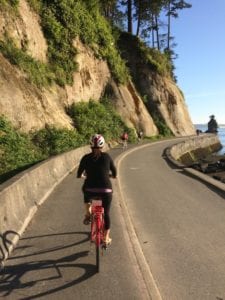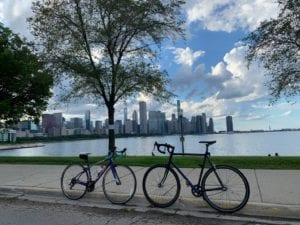Voices: Cycling Wellness into Your Life | Sarah Ackroyd, MD

Sarah Ackroyd, MD
In entering medicine, I abstractly understood that our field requires hard work. I found the idea of focused, diligent training and practice appealing, but I didn’t know what hard work truly looked like until I was well into my education. In medical school, my classmates and I were constantly reminded that our job would require long hours, dedication, physical demands, and being resilient when facing emotional and mental challenges. Gynecologic oncology as a subspecialty particularly speaks to this. But as young student doctors, we were assured that if we learned to take care of ourselves, we could build the endurance required to lead a successful career.
In learning about the importance of wellness, the principle of whole-person care was ingrained in us through our learning about the biopsychosocial model. Developed by a University of Rochester internist-psychiatrist George Engel, MD, this model strives to contextualize patient care by incorporating the biology, psychology and socio-environmental aspects of a person into a patient-centered assessment (1). While this mostly applied to the philosophy of how to take care of patients, it also spoke to the way we were encouraged to take care of ourselves. Through this foundational framework, I was inspired to find a durable way to take care of myself throughout my training.

A ride on a bicycle trail at Sterling Park on a trip to Vancouver, BC.
As I entered my clinical rotations and just as I was starting to search for what part of medicine really resonated with me, I also was working to discover my version of wellness. This is when I found cycling.
Pedaling through the hills surrounding Rochester, NY, I felt myself growing stronger. There are clear health benefits to cycling. Population-based studies report that people who cycle have improvements in BMI, cholesterol, blood pressure, diabetes incidence and up to a 28 percent reduction in risk of all-cause mortality (2-4). Cycling has also been shown to improve cognitive function, reduce stress, and improve overall psychological well-being (5). Many of these benefits are appreciated with indoor cycling too.
I learned that a ride could give me so much more than just an aerobic exercise. Riding creates a sense of both freedom and control. You chose the length, the effort, the stops, and the challenges. The bike allows you to channel your energy into every pedal stroke. The rhythmic motion creates a transient mindful state. To me, nothing is more therapeutic than the meditation of pedaling.

A typical bicycle stop on the Chicago waterfront.
The bicycle is also a versatile canvas. You can build cardiovascular strength through short climbs or long endurance rides. You can deepen your social network through group rides. Some of my best creative moments have come from sharing thoughts with a friend over a long ride. You can travel and explore a new place by riding the bike trails that pass through cities, villages, and the countryside. My travel plans always incorporate some aspect of cycling. And if you’re ambitious, like the gynecologic oncologist and chairman at my institution, Ernst Lengyel, MD, PhD, you can even commute via bike—even in the Chicago winter!
The bicycle is my key to wellness. It is a means for me to think, to socialize, to travel, to see the world, and to challenge my fitness. Finding the right wellness activity requires a commitment to understanding what you enjoy and how it can sustain your emotional, physical and social wellbeing. Take some time to figure out what wellness activity spins your wheels.
Sarah Ackroyd, MD, is a gynecologic oncology fellow at University of Chicago Hospitals in Chicago, IL.
- Epstein RM. Realizing Engel’s biopsychosocial vision: resilience, compassion, and quality of care. Int J Psychiatry Med. 2014;47(4):275-87.
- Huy C, Becker S, Gomolinsky U, Klein T, Thiel A. Health, medical risk factors, and bicycle use in everyday life in the over-50 population. J Aging Phys Act. 2008;16(4):454-64.
- Wen LM, Rissel C. Inverse associations between cycling to work, public transport, and overweight and obesity: findings from a population-based study in Australia. Prev Med. 2008;46(1):29-32.
- Andersen LB, Schnohr P, Schroll M, Hein HO. All-cause mortality associated with physical activity during leisure time, work, sports, and cycling to work. Arch Intern Med. 2000;160(11):1621-8.
- Leyland LA, Spencer B, Beale N, Jones T, van Reekum CM. The effect of cycling on cognitive function and well-being in older adults. PLoS One. 2019;14(2):e0211779.